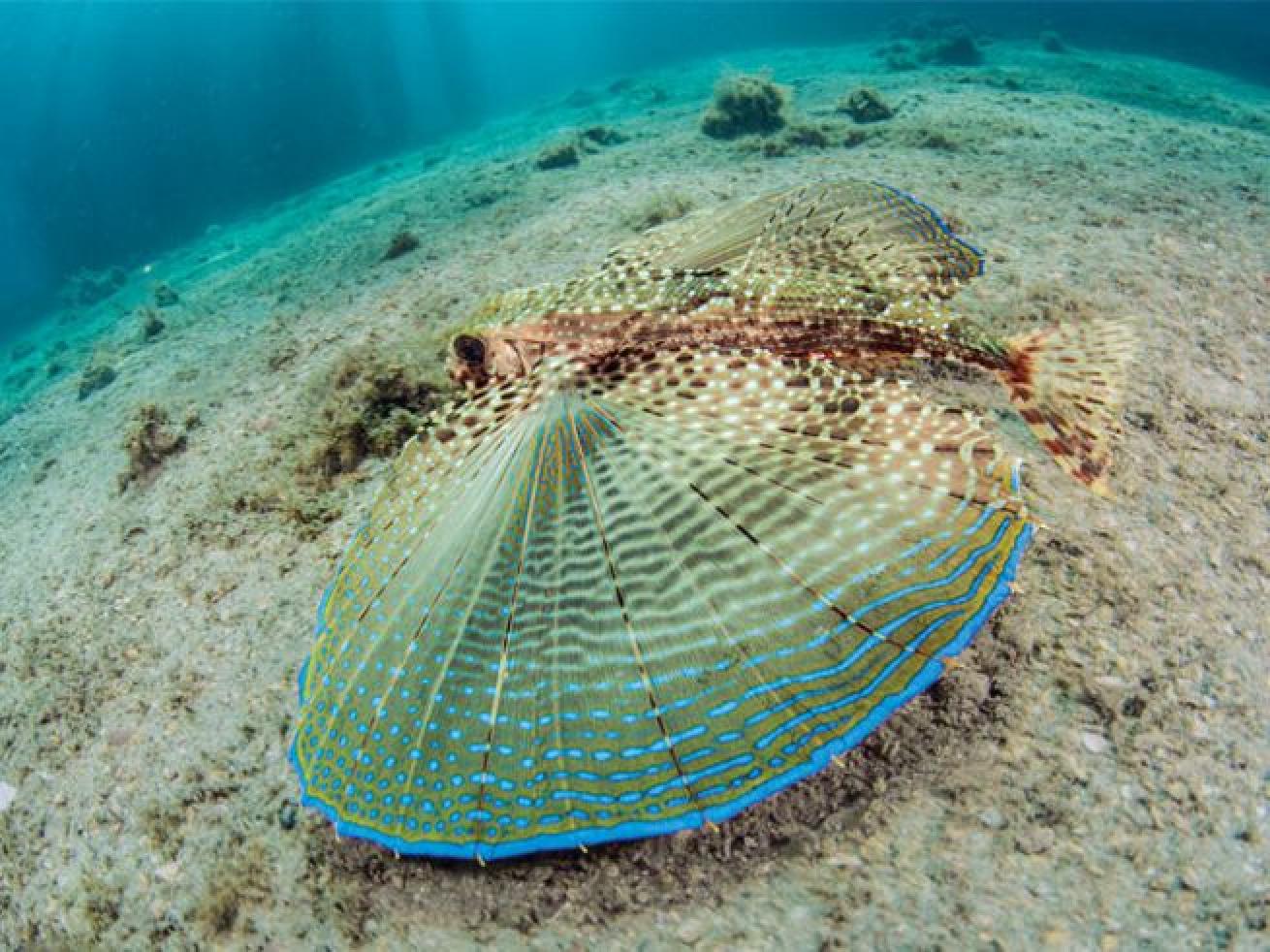The Best Scuba Diving Sites For Every Depth
Divers are obsessed with depth. How deep we go has become bravado-infused shorthand for our dive experience and our comfort in the water. But any truly experienced diver worth his or her salt will tell you it isn’t the depth of the dive, but rather the quality of the experience that matters. To prove the point, we’ve pulled together some of our favorite dives from every depth in the recreational-diving range — from a mind-blowing 10-foot dive in Florida that will make you wish every dive were this shallow, to a heart-wrenching wreck in Micronesia that is worth every second of its 10-minute bottom time.

Dives for Every Depth
You know where you're most comfortable in the water. Here are 13 knock-your-fins-off dives — from 10 to 130 feet — to match your inner depth finder.

Wilfred Hdez10 feet - Blue Heron Bridge
Florida, USA
In water that Yao Ming could practically stand in, shore-loving divers at Blue Heron Bridge in Riviera Beach, Florida, can spot some of the sea’s most unusual critters — everything from hairy frogfish and flying gurnards to spotted eagle rays and manatees. Tidal currents and a busy boat channel nearby mean this easy beach dive requires a little advance planning, but if you wade in 20 minutes before the current slacks at high tide, you’ll have calm waters and the chance to see weird creatures you thought were only in exotic Pacific destinations — including long-arm octopuses, stargazers and seahorses. At Phil Foster Park, a recently added swim zone features an artificial reef of boulders and concrete blocks along an 800-foot snorkel trail; the surrounding cement pilings provide shelter for even more critters.
Contact: jupiterdivecenter.com

Michael Patrick O'Neill10 feet - Blue Heron Bridge Florida, USA
In water that Yao Ming could practically stand in, shore-loving divers at Blue Heron Bridge in Riviera Beach, Florida, can spot some of the sea’s most unusual critters — everything from hairy frogfish and flying gurnards to spotted eagle rays and manatees. Tidal currents and a busy boat channel nearby mean this easy beach dive requires a little advance planning, but if you wade in 20 minutes before the current slacks at high tide, you’ll have calm waters and the chance to see weird creatures you thought were only in exotic Pacific destinations — including long-arm octopuses, stargazers and seahorses. At Phil Foster Park, a recently added swim zone features an artificial reef of boulders and concrete blocks along an 800-foot snorkel trail; the surrounding cement pilings provide shelter for even more critters.
Contact: jupiterdivecenter.com

Michele Westmorland20 feet - Samurai Pier
Milne Bay, Papua New Guinea
A once bustling port at the fringe of Papua New Guinea’s Milne Bay, the historic pier at Samurai Island may not see many boats anymore, but the coral-encrusted pilings, discarded clam nets and other detritus scattered beneath the pier still draw staggering levels of marine-life traffic. Descend alongside the crumbling pilings and sink into a vast school of shimmering baitfish before touching down on the jumbled debris floor. The 20-foot dive bursts not only with exotic muck creatures like harlequin shrimp and ghost pipefish, but also larger creatures like wobbegong sharks and batfish. Enjoy nearly unlimited bottom time tipping up bottles, boots and half coconut shells among the pilings in search of pipefish, stonefish and octopuses.
Contact: papuanewguinea.travel
Related Reading: Six Unexpected Dive Adventures Around the World

Reinhard Dirscherl30 feet - Dos Ojos Cenote Riviera Maya, Mexico
The Maya believed that cenotes were the entrance to Xibalba, the Mayan underworld, but divers know that the freshwater sinkholes of Mexico’s Yucatan Peninsula are doorways to the largest subterranean-river system in the world. From the mouth of the cavern at Dos Ojos, divers can follow two lines. The Barbie Line to the right follows a well-lit path into the jagged mouth of the second opening, where towering stalactites hang like teeth in a gaping mouth. To the left, the Bat Cave Line follows a side branch, a darkened tunnel filled with delicate soda-straw formations leading to a massive chamber half-filled with air, the ceiling hung with clusters of small bats.
Contact: phoceamexico.com

Wendy Capili-Wilkie40 feet - Blue Corner
Palau
No matter where you look, you’ll experience a head-spinning adrenalin rush while diving at Palau’s Blue Corner. This exposed reef juts into current-swept waters teeming with sharks, fish and turtles. The name of the game here is reef-hooking, a practice born at Blue Corner in which you descend along the swiftly rising current to the action zone at around 40 feet, where you use a hook and lanyard to stay in one spot on the reef, allowing the marine life to sweep past in an endless parade.
Contact: sportdiver.com/palau

Stephen Frink Collection/Alamy50 feet - Benwood
Key Largo, Florida
When most divers think of wreck diving in the Florida Keys, their minds immediately go to massive artificial reefs like the Spiegel Grove and Vandenberg, but in fact, one of the most popular Keys wrecks sits no deeper than 50 feet. The Benwood was a merchant-marine freighter that sank in a collision in 1942, and more than 70 years on the seafloor has made it a veritable reef in its own right; today it is caked in corals, frosted by vast forests of Christmas tree worms, and home to an incredible population of reef fish. Snapper, goatfish and grunts pack the holds, while queen angelfish and trumpetfish hover along the superstructure. Return at night to see the ship in a whole new light, with lobsters and green morays cruising the open decks.
Contact: horizondivers.com

Joel Penner60 feet - First Cathedral
Lanai, Hawaii
Divers say it’s a religious experience, and that First Cathedral — one of Maui County’s most picturesque dives — is aptly named. Follow the mooring line to the foot of an undersea pinnacle, a massive rock dome created from a bubble of ancient lava. The entrance appears like a mere crack in the wall, but fin through the fissure and the room opens before you. Once inside, the “cathedral” part of the name becomes apparent. Roughly cross-shaped with a long aisle and two arms, a hole in the ceiling over the center point sends shafts of light onto a massive boulder, illuminating it like a stained-glass window in a church sanctuary. Take the left arm to the floor- level exit, nicknamed the Champagne Cork, where you can time your fin kicks with the ocean’s surge to soar onto the outside reef.
Contact: goscubadivemaui.com

Phillip Colla70 feet - Wolf Island
Galapagos
Remote and wild — home to ripping currents, steep walls, crazy-big schools of pelagic fish, and packs of sharks — Wolf Island is the pinnacle of Galapagos diving. Drop down to an ideal depth of 70 feet, and just sit back and enjoy the show: Galapagos sharks prowl the seas, whitetips writhe and flow from cracks and crevices in the rocks, and out in the blue water, a never-ending swarm of scalloped hammerheads — gorgeously silhouetted by the sun — slowly swirl the island like moths around a giant flame.
Contact: aggressor.com

Gregory Piper80 feet - Shark Airport
Tubbataha, Philippines
The remote Tubbataha Reef National Park is in the heart of the Philippines’ Sulu Sea. Accessible only by liveaboard, and with a dive season that’s a mere three months long, these little-disturbed reefs remain in pristine condition. At the signature site Shark Airport, you’ll drop onto a wide, shallow plateau that leads to a shelf at 80 feet. Expect close encounters with the many whitetip reef sharks that buzz the landing strip. Jacks, rainbow runners and snapper cruise past on the ocean currents, while the reef itself is a color-laden candy store of soft and hard corals.
Contact: sirenfleet.com
Related Reading: 6 Stunning Seamounts Perfect for Scuba Diving

Damien Mauric90 feet - SS Thistlegorm
Red Sea, Egypt
The most clamored-for dive in the Red Sea is also one of the greatest wreck dives in the world. A British supply ship in World War II, the Thistlegorm was bringing a cargo of much-needed supplies to Allied troops when it was spotted by German bombers and dispatched to the seafloor off the tip of the Sinai Peninsula. Never salvaged, it was eventually rediscovered by Jacques Cousteau and his Calypso crew. Today the ship stands as an undersea museum, its cargo holds still packed to the gills with Bedford trucks, BSA motorcycles, boots and rifles.
Contact: aggressor.com

Jennifer O'Neil100 feet - Karpata Bonaire
There’s no shortage of great dives at any depth on Bonaire, but most visitors to this shore-diving mecca will agree that one of the best deep reefs can be found at Karpata. Park at the iconic yellow-painted rock marking the site’s location, and from there, a short walk down a stairway leads to an easy entry and steep, sloping reef that quickly transitions into a near-vertical wall. Descend to around 100 feet for stunning views of the pristine reef towering above, sunlight streaming through the crystal-clear water, while parrotfish, triggerfish and snappers dance in the water column. Small caves dot the reef wall, so bring a light to look for moray eels and lobsters hiding in the recesses.
Contact: buddydive.com

Carlos Villoch110 feet - Odyssey
Roatan, Bay Islands
The cargo freighter Odyssey was being rebuilt in Roatan’s French Harbour in 2002 when it caught fire. The flames raged for days, and eventually local dive-shop owners offered the solution. They sank the ship as an artificial reef off Mud Hole on the island’s north coast. From bow to stern the wreck is 300 feet long, but the main attraction is the accommodations quarters at the stern — the holds that once comprised the middle of the ship have mostly collapsed — and at the back end the picturesque tower boasts the zigzagging lines of exterior stairways laden with soft coral growth. Swim up the stairways to the crew quarters to find wide-open rooms now inhabited by angelfish and barracuda.
Contact: palmettobayplantation.com

Debbie Arriaga120 feet - Kaleidoscope
Raja Ampat - Indonesia
Named for the cylindrical kaleidoscopes that use mirrors and colorful glass beads to create beautiful patterns, the reef here has a magic all its own, carpeted with a dizzying array of soft corals and critters. Off the western tip of Papua, New Guinea, the Raja Ampat islands are a remote, 1,500-island chain in Indonesia where divers’ dreams come true. A hotbed of biodiversity at the heart of the Coral Triangle, Raja Ampat has something for every diver. At Kaleidoscope, that something is brightly colored creatures. Look closely at the pink gorgonian fronds to spot fingernail-size pygmy seahorses, or enlist your divemaster’s help in finding rare nudibranchs, rhinopias and ornate ghost pipefish. While Kaleidoscope is primarily a small-critter dive, it’s not uncommon to spot blacktip reef sharks or mobula rays finning their way across the reef.
Contact: thearenui.com

Todd Winner130 feet - Nippo Maru
Truk Lagoon - Chuuk
During WWII, American bombers crushed the Japanese Imperial fleet at this remote outpost during Operation Hailstorm, sending 60 ships and hundreds of planes to the bottom of the lagoon. The Nippo Maru was a cargo ship torpedoed by a U.S. submarine. Like the Thistlegorm in Egypt, the Nippo Maru holds a treasure trove of artifacts, including a tank and artillery guns on the deck, and holds packed with trucks, motorcycles, jeeps and ammunition, and you’ll be tailed by squadrons of barracuda, jacks and giant napoleon wrasse. The dive depth marks the end of the recreational limit, and some of the ship lies even deeper, so bottom time is short — the memory of this haunting wreck will last far longer.
Contact: trukodyssey.com









